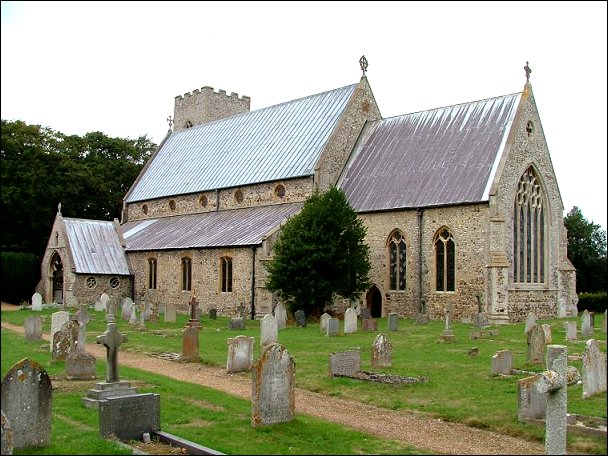| |
|
St Mary,
Old Hunstanton
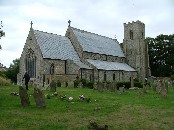 |
|
Hunstanton,
the big, brash seaside resort, hugs the coast for
a few miles, the only westwards facing resort on
the entire English east coast, if you exclude the
villages that straggle to the south of it. Until
the 19th century, the town did not exist; it was
the creation of the Le Strange family of
Hunstanton Hall. They laid out the streets, built
the houses and shops, and landscaped the coast in
the hope and expectation that people would come;
and they did come, in their thousands, making the
Le Strange family an unfeasibly large fortune. There was
always a village of Hunstanton, to the north of
the present town, and inevitably this became
known as Old Hunstanton.
|
It is
dominated by the park of Hunstanton Hall, and in the
grounds of the hall is quite one of the biggest churches
in this part of Norfolk, the original Hunstanton parish
church of St Mary. Frederick Preedy built a chapel of
ease to this church down in the new town, and St Edmund
today serves the population there as a parish church in
its own right. But inevitably, St Mary feels like the
mother church, and this a sense which is accentuated by
its sheer grandeur and delicious Victorianisation.
Preedy was
Henry Le Strange's cousin, and so not unreasonably he was
brought in to do the massive restoration of St Mary.
Almost everything you see is of the 19th century,
although internally the arcades survive from the earlier
church. The tower too, remains in its original position
to show that the north aisle was the site of the original
church. But today the building is greatly enlarged. You
step inside to see a Norman font set on a high pedestal
in a sea of spectacular glazed 19th century tiles, a
juxtaposition which depicts, in essence, the journey that
this building has made over the centuries.
Preedy's
east window tracery is spectacular, but a major 19th
century restoration is made or broken by its glass, and
that at St Mary is consistently good. There is a fine
tree of Jesse, effectively Christ's family tree, an
articulate and unusual expression of 19th century
theology. There are some very good Old Testament scenes:
Abraham greeting the three angels while his wife Sarah
watches from behind the door is haunting. In an adjacent
scene, an angel arrives in the nick of time to save Isaac
from his father's sacrificial knife, in what must be the
most terrifying story in the entire Bible. A third shows
Abraham sending Hagar into exile with her son Ishmael.
Ishmael, of course, is Abraham's first born son, but was
disinherited by the birth of Isaac. This is a fairly
unusual scene in 19th century glass, but is particularly
pertinent in the present troubled times; Ishmael is
considered by Muslims to be an ancestor of the prophet
Mohammed, and as such is a venerated patriarch of Islam.
Sarah watches from the door with understandably mixed
feelings.
The modern
Annunciation is a little insipid for my tastes, but
provides a nice counterpoint to the richness of its
Victorian neighbours.
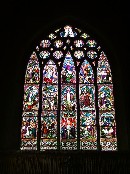 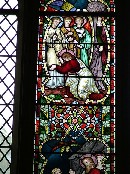 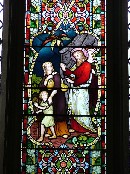 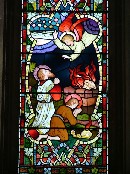
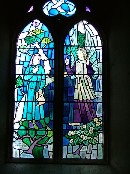 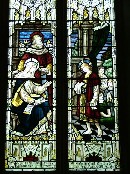 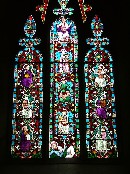 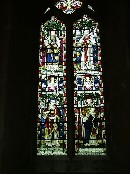
St Mary is
not without is medieval survivals, including an excellent
rood screen depicting the twelve apostles on its panels.
Unfortunately, we visited after a major society wedding,
and it was beyond possiblity that we could have moved the
simply enormous flower arrangements from in front of the
screen and returned them safely in one piece. Though I
did think about it. However, I will have to go back at
some point, and perhaps the photographs I did take show
it looking rather attractive after all. There are several
good Le Strange memorials. There is also a fine 1480
double figure brass of Edmund Grene and his wife under
the old Stuart communion table, itself now in use for
books and magazines, in the far south-west corner.
But best
of all, I loved the feel of 19th century confidence,
which has not become dour with age, but feels vibrant,
coherent and rather magnificent. This super church is
full of colour and light, and a sense of being loved and
used.
|
|
|

